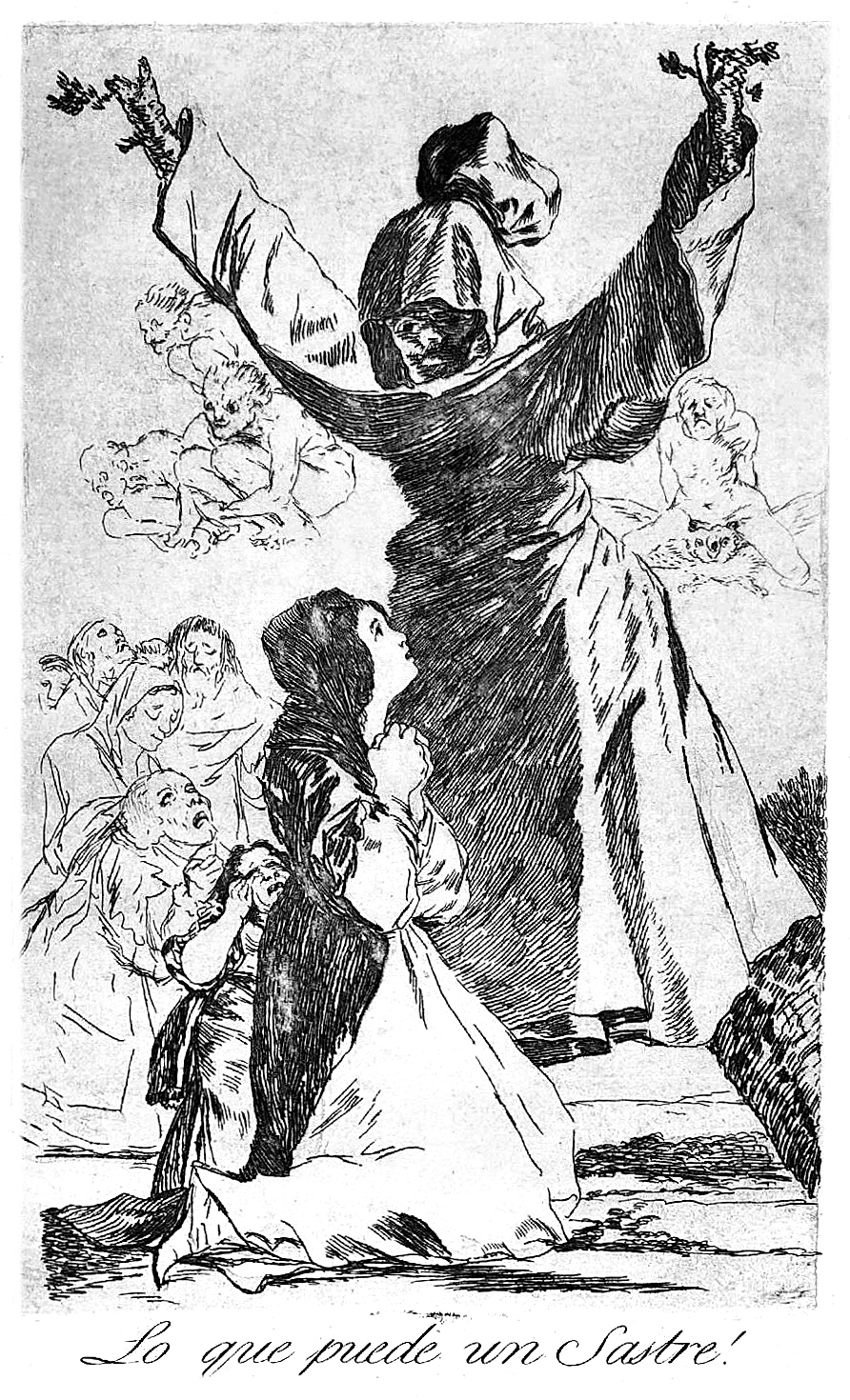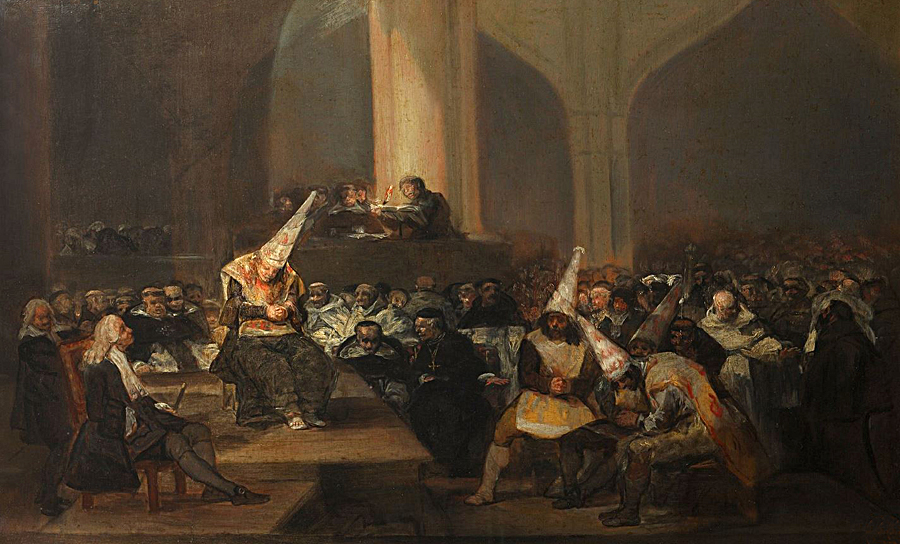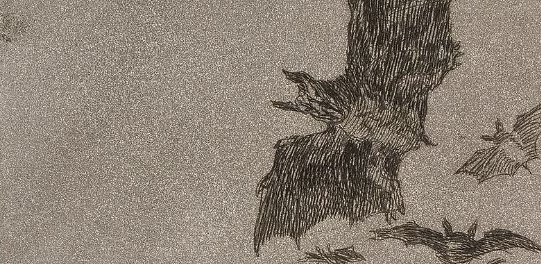Goya and the Sleep of Reason
In the late 1700s the Spanish artist Francisco de Goya y Lucientes (1746-1828) created a series of eighty etchings he titled Los Caprichos (The Caprices). An irrational thought or action can be a “caprice,” and Spanish society at the time provided Goya with myriad examples of ferocious caprices.
For instance, Goya created paintings and prints that wryly scrutinized the Spanish Inquisition, which began in 1478 and only ended in 1834. The Inquisition was used to preserve the power of Catholic orthodoxy, and eventually it turned its cruel gaze upon the artist’s critical artworks. Goya, a reformer who believed in Enlightenment ideals, was destined to clash with the authorities of the fundamentalist Inquisition.
One print from Goya’s Los Caprichos etching series was titled Lo que puede un sastre! (What a Tailor Can Do!) It was an impishly sarcastic proclamation on how ruling elites get their way.

In the print the ancien regime is represented by an unseen tailor who has dressed up a dead tree with a robe. With the title of his print Goya asserted, What a tailor can do! But his visual retort showed that the tailor—or the overlords, can outfit a lifeless gray tree in the finest vestments of authority, to create an apparition of absolute power that will have commoners groveling on their knees in submission. So it was in 1799, so it is today.
Goya’s painting Escena de Inquisición (The Inquisition Tribunal), shows the interior of a Church were apostates are undergoing the ritual of public penance known as auto-da-fé; a ritual that often times incorporated torture.

Auto-da-fé (Portuguese: “act of faith”) was an orchestrated event that took months to organize. Anyone accused of being a heretic was presumed to be guilty and would likely be tortured to extract a confession of guilt. The ordeal ended with a Catholic Mass and a procession of prisoners who had been found guilty. They were forceably dressed in costumes that connoted their crimes, then marched off to the Quemadero (burner), a place of execution where, according to the severity of their offenses, the prisoners were whipped, strangled to death, or burned at the stake.
Goya was twice summoned by the Inquisition. His first ordeal came in 1799 after he created his Los Caprichos etchings; and in 1808 he was called before the Inquisition when ecclesiastical authorities found his hidden paintings The Naked Maja and The Clothed Maja (1797-1800), in the possession of Manuel Godoy, who at the time was the Prime Minister of Spain. In both instances Goya somehow escaped the wrath of the Inquisition.
Manuel Godoy likely commissioned Goya to create the Maja canvases for his personal collection of nude paintings, which the Prime Minister kept hidden in a private room. In 1808 Inquisition investigators somehow discovered that Godoy possessed the “questionable pictures.” Godoy was dragged before an Inquisition tribunal and forced to reveal the name of the artist who dared to create the paintings thought to be “indecent and prejudicial to the public good.”
Interestingly enough, the Inquisition’s attack against Godoy coincided with the street mobs who demanded the Prime Minister be removed from his position. Essentially the Inquisition mounted a political attack in the guise of religious orthodoxy. Since Manuel Godoy merely possessed the painted outrages, Francisco Goya was brought before an Inquisition tribunal in 1808 on a charge of “moral depravity,” or was it for distributing “misinformation”? I don’t recall.
The Inquisition tribunal released Goya only when they determined his Maja paintings followed a tradition set by the Venetian painter Titian, who painted the Danaë series of paintings, and the Spanish painter Diego Velázquez, who painted Venus at her Mirror… paintings that had previously been approved by the King of Spain, Philip IV.
Also from the Los Caprichos series of etchings, Goya created what is perhaps his most well know print from that series, El sueño de la razón produce monstruos (The Sleep of Reason Produces Monsters).
The Sleep of Reason is a work that has haunted me for decades, it continues to do so. Goya wrote about the artist depicted in his etching: “His only purpose is to banish harmful, vulgar beliefs, and to perpetuate in this work of caprices, the solid testimony of truth.”

It has long been surmised that the artist pictured in the etching is Goya himself, and I have no reason to doubt that. All down the ages the meaning of Goya’s etching has confronted artists; it admonishes us to create art that delivers the “solid testimony of truth.” To this very day Goya’s print warns us of our folly.
Strangely enough, artists no longer receive the message; postmoderns tell us truth is relative, it is just a social construct they say. But that’s a lie. Without truth we are left pitiably diminished and spiritually marooned. Just look at us in 2023—reason escapes us as our minds are put to sleep by trash culture, the incessant blathering of televised idiots, and other mechanisms of our postmodern gulag.
Yes, the sleep of reason produces monsters, and nowadays we are surrounded by terrifying monstrosities. Just look around as those irrational thoughts and actions just keep piling up.
Might I remind the reader, on March 30, 2023 former Speaker of the House Nancy Pelosi chimed in on Twitter regarding the indictment of former President Trump, she said: “The Grand Jury has acted upon the facts and the law. No one is above the law, and everyone has the right to a trial to prove innocence.”
Ms. Pelosi did not misspeak, her statement unfortunately reflects the position of the entire Democrat Party and its media sycophants. It must be said that it was once acknowledged that American jurisprudence insisted a citizen is innocent until proven guilty. Formerly that was an enshrined bipartisan fact… until Orange Man Bad arrived.
But as those demonic owls and bats—escapees of Goya’s Sleep of Reason, flap around our somnambulic heads, we collectively fall into a deep, restful slumber… never to be bothered by reason ever again.


